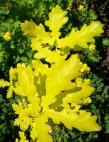Quercus rubra 'MAGIC FIRE'

Quercus rubra 'MAGIC FIRE'
red oak
red oak
| SIZE/TYPE | medium-sized tree |
|---|---|
| USUAL HEIGHT | 8-15m |
| USUAL WIDTH | 4-8m |
| LEAVES | deciduous broadleaf |
| COLOUR OF LEAVES |
 + + multicoloured:yellow and light green multicoloured:yellow and light green |
| FLOWERS | insignificant or non-blooming |
| COLOUR OF FLOWERS |
 light green light green
|
| LOCATION | full sun |
| SOIL TYPE | acidic (peaty) to neutral |
| USDA zone (lowest) | 3 (down to -40°C) |
| WINTER PROTECTION | |
| FOR ZONE 5+6 |

|
| FOR ZONE 7 |

|
| BELONGS TO CATEGORIES | Deciduous broadleaf |
Oaks are common trees of our natural woodlands. They border our ponds, occur naturally in our mixed forests, and make magnificent specimen trees in our parks and arboretums where less common species or rare varieties can be seen. Red oak is also called American oak thanks to its origin in north-eastern USA and Canada, owing to which it is very cold hardy. And just like many other very hardy trees also this one gets considerably tall when adult. Yet there are smaller varieties which will fit a mid-sized garden.
Magic Fire is an attractive selection of red oak with yellow to chartreuse foliage and smaller size. Its leaves are deciduous, 15-20 cm long, cut into bristle-tipped 7-11 lobes. Contrary to its common this variety does not produce red colour in autumn, only yellow and orange. In May are formed pale green catkins producing allergenic pollen.
It grows moderately to fast into a pyramidal shape when young and becomes rounded with age, casting a pleasant, not very deep shade. Young trees benefit from staking the central leader and pruning lateral branches to form a symmetrical and strong framework. In gardens it grows some 8-10 m tall and half as wide, while in parks and arboretums with plenty of space for roots it will reach some 15 m tall.
Oaks are not fussy about soil type, but this one needs lime-free soil (neutral or acidic). They do well in well-drained soil, moist is good but boggy is fatal. Once established they withstand drought and city pollution as well as road salt. Newly planted trees need to be staked into a strong support for 2-3 years to establish. Roots are strong only near the trunk and can heave fragile garden pavements if too close, however, they exhibit no problem when the tree is planted as an alley tree close to roadways or sturdy pavements. Fully hardy to -40°C (USDA zone 3).
Last update 01-01-2007; 02-02-2021
Magic Fire is an attractive selection of red oak with yellow to chartreuse foliage and smaller size. Its leaves are deciduous, 15-20 cm long, cut into bristle-tipped 7-11 lobes. Contrary to its common this variety does not produce red colour in autumn, only yellow and orange. In May are formed pale green catkins producing allergenic pollen.
It grows moderately to fast into a pyramidal shape when young and becomes rounded with age, casting a pleasant, not very deep shade. Young trees benefit from staking the central leader and pruning lateral branches to form a symmetrical and strong framework. In gardens it grows some 8-10 m tall and half as wide, while in parks and arboretums with plenty of space for roots it will reach some 15 m tall.
Oaks are not fussy about soil type, but this one needs lime-free soil (neutral or acidic). They do well in well-drained soil, moist is good but boggy is fatal. Once established they withstand drought and city pollution as well as road salt. Newly planted trees need to be staked into a strong support for 2-3 years to establish. Roots are strong only near the trunk and can heave fragile garden pavements if too close, however, they exhibit no problem when the tree is planted as an alley tree close to roadways or sturdy pavements. Fully hardy to -40°C (USDA zone 3).
Last update 01-01-2007; 02-02-2021
SIZES and PRICES
CURRENTLY SOLD OUT
GLOSSARY
|









